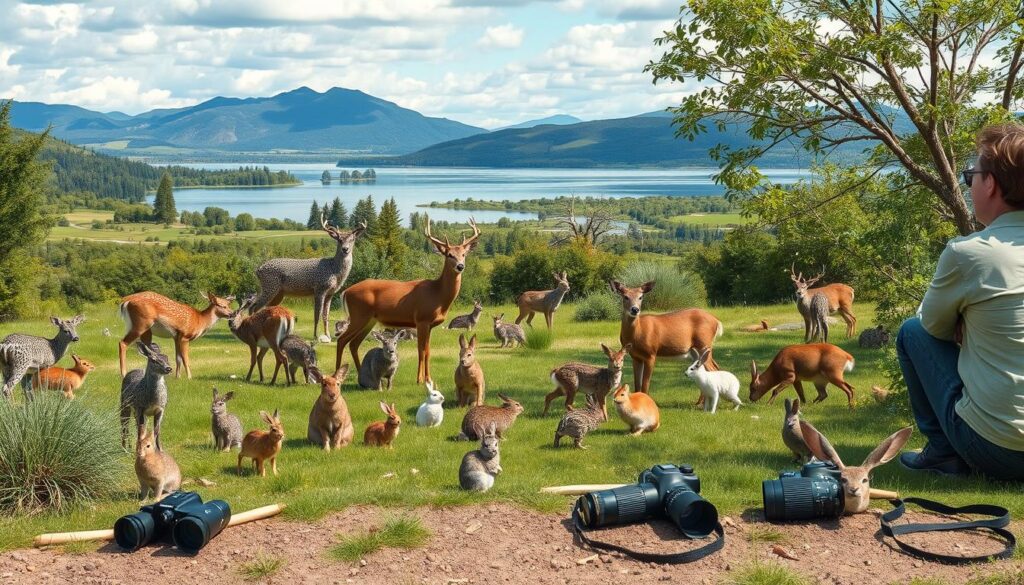Wildlife watching lets you connect with nature’s amazing creatures. It’s vital to observe wildlife responsibly to protect their habitats. By following guidelines, you can enjoy wildlife without disrupting their natural behaviors12.
Federal laws protect various wildlife species. The Marine Mammal Protection Act and Endangered Species Act set boundaries for human-wildlife interactions. These laws keep endangered species and their habitats safe1.
Responsible wildlife watching needs awareness and respect. Animals show distress signals when humans get too close. Birds may bob their heads, while marine mammals change swimming patterns1.
Staying at a safe distance and being quiet helps reduce stress on wildlife. This approach ensures you can observe without causing harm2.
Key Takeaways
- Respect wildlife by maintaining a safe distance
- Follow federal guidelines for wildlife protection
- Learn to recognize signs of animal distress
- Support conservation through responsible observation
- Avoid direct interaction with wild animals
Understanding Wildlife and Its Importance
Wildlife is the backbone of our planet’s ecological balance. These wild creatures, from tiny insects to huge mammals, keep nature in harmony. They form a complex web of life that’s crucial for our world3.
What is Wildlife?
Wildlife includes all free-living animals in nature. Each species plays a unique role in protecting the environment. These amazing creatures adapt and survive through complex interactions4.
The Role of Biodiversity
Biodiversity is key to healthy ecosystems. Different species work together in amazing ways. They support life on Earth through various processes.
- Pollination by insects and birds
- Seed dispersal through animal movements
- Nutrient cycling in ecological systems
Since 1970, global wildlife populations have dropped by 68%. This sharp decline shows we urgently need to boost conservation efforts5.
Why Conservation Matters
“Conservation is a state of harmony between humans and land.” – Aldo Leopold
Studying animal behavior helps us value wildlife’s role in nature. Conservation protects endangered species and keeps genetic diversity intact. It also ensures healthy ecosystems for future generations3.
| Conservation Aspect | Impact |
|---|---|
| Habitat Protection | Preserves biodiversity |
| Species Preservation | Maintains ecological balance |
| Community Engagement | Promotes environmental awareness |
Protecting wildlife isn’t just about saving animals. It’s about preserving the delicate balance of life on our planet4.
Best Practices for Responsible Wildlife Watching
Observing wildlife requires thoughtful, respectful approaches. Your commitment to sustainable practices can protect animals and their habitats. This safeguards both the environment and animal behavior.
Wildlife watching needs careful attention to ethical guidelines. These protect animals and their homes. National park experts suggest specific strategies for responsible wildlife encounters.
Maintain a Safe Distance
Keeping a safe distance is vital for animal welfare. 70% of wildlife watchers research local animal species before observing them6.
Consider these key guidelines:
- Use binoculars or spotting scopes for close-up views
- Move slowly and quietly to minimize disturbance
- Avoid approaching nests or animal dens
Follow Local Guidelines
85% of wildlife observation locations have specific regulations to protect animals and ecosystems6. Your responsibilities include:
- Stay on designated trails
- Close gates after passing through
- Keep pets secured
- Respect local conservation rules
Use Eco-friendly Equipment
Choosing the right gear minimizes environmental impact. 60% of wildlife observers bring specialized viewing equipment like binoculars6.
Recommended practices include:
- Use telephoto lenses for photography
- Avoid flash photography
- Bring waste bags to remove all trash
“Respect nature, and nature will reveal its wonders to you.” – Wildlife Conservation Expert
Finding the Right Wildlife Watching Experiences
Research is key for an extraordinary wildlife adventure. Seek destinations with unique animal observation opportunities. Wildlife refuges offer diverse species viewing, often near towns for easy access78.
Consider your comfort level when selecting experiences. Guided tours by expert naturalists provide deep insights into species and ecosystems. Solo adventures suit those with wildlife knowledge7.
Some places, like the Galapagos Islands, showcase unique wildlife. These destinations offer unparalleled opportunities to see rare species7.
Ethical wildlife organizations prioritize animal welfare. They follow strict guidelines for minimal environmental impact. Look for facilities committed to conservation and animal welfare standards9.
Your choice of tour operator influences wildlife tourism practices. It can support broader conservation efforts. Responsible operators help protect our planet’s biodiversity9.
Embrace responsible observation principles on your wildlife journey. Use binoculars to keep a safe distance. Follow local guidelines and choose experiences that put animal well-being first8.
FAQ
What is responsible wildlife watching?
Why is maintaining a safe distance important when watching wildlife?
What are some legal protections for wildlife?
How can I tell if I’m disturbing wildlife?
What should I do if I encounter an injured or stranded animal?
How can I contribute to wildlife conservation?
What equipment should I use for responsible wildlife watching?
Why is biodiversity important?
Source Links
- Wildlife Viewing Guidelines: Recreate Responsibly – https://sanctuaries.noaa.gov/wildlife-viewing/
- Guidelines for wildlife watching – https://www.responsibletravel.com/holidays/wildlife/travel-guide/guidelines-for-wildlife-watching
- What is the goal of wildlife conservation? | IFAW – https://www.ifaw.org/journal/goal-widlife-conservation
- Ecology & Society: The values of wildlife revisited – https://ecologyandsociety.org/vol27/iss4/art23/
- Wildlife – https://en.wikipedia.org/wiki/Wildlife
- Best practices for Responsible wildlife observation – https://wildexpedition.com/best-practices-for-responsible-wildlife-observation/
- Top 10 wildlife experiences – https://www.responsiblevacation.com/vacations/wildlife/travel-guide/top-10-wildlife-experiences
- Wildlife Viewing | U.S. Fish & Wildlife Service – https://www.fws.gov/story/wildlife-viewing
- Tips for responsible wildlife tourism – https://www.nationalgeographic.com/travel/article/how-to-do-wildlife-tourism-right
